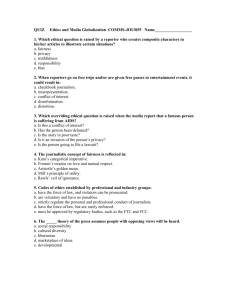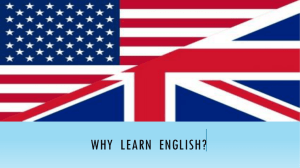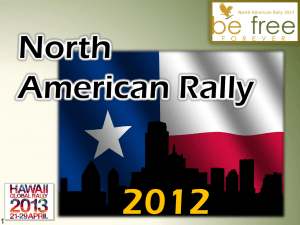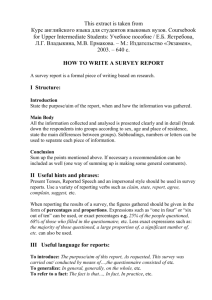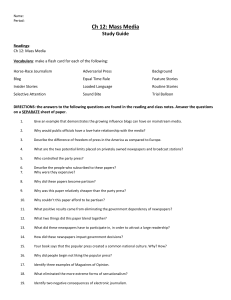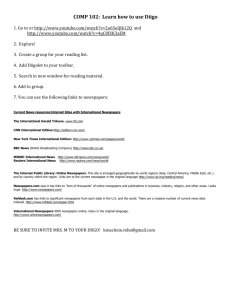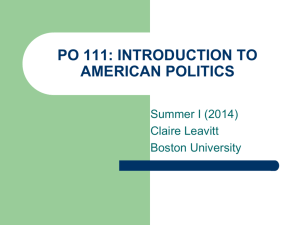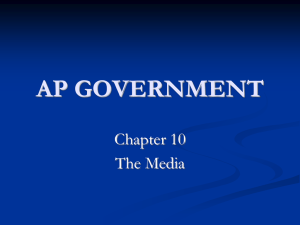Document 10466266
advertisement
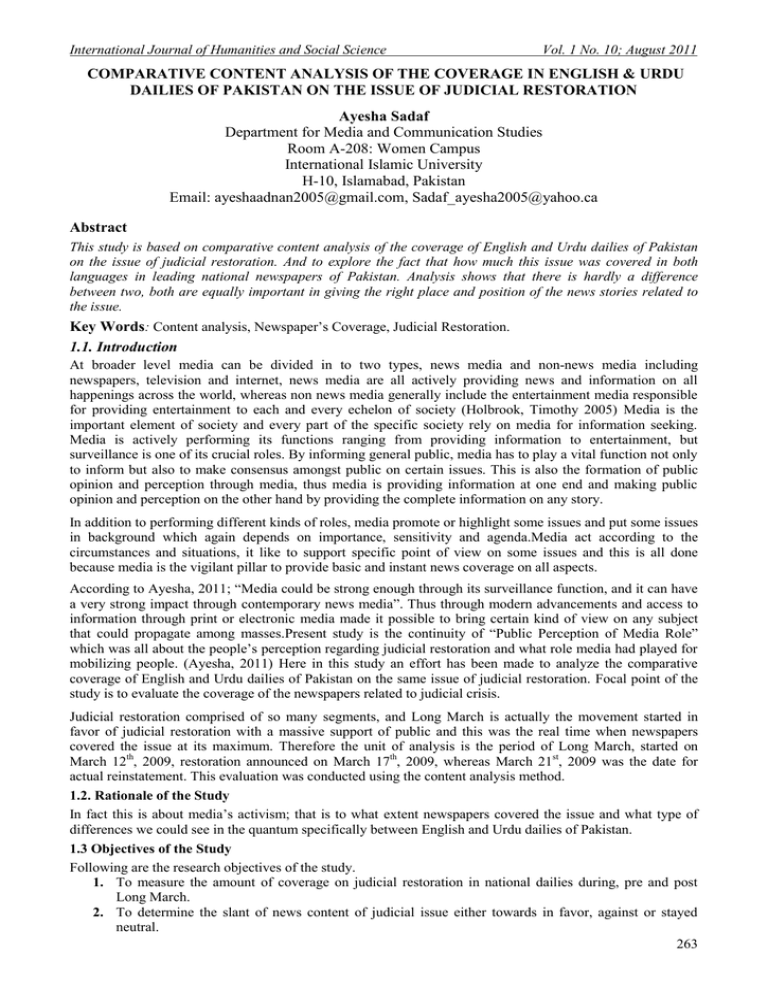
International Journal of Humanities and Social Science Vol. 1 No. 10; August 2011 COMPARATIVE CONTENT ANALYSIS OF THE COVERAGE IN ENGLISH & URDU DAILIES OF PAKISTAN ON THE ISSUE OF JUDICIAL RESTORATION Ayesha Sadaf Department for Media and Communication Studies Room A-208: Women Campus International Islamic University H-10, Islamabad, Pakistan Email: ayeshaadnan2005@gmail.com, Sadaf_ayesha2005@yahoo.ca Abstract This study is based on comparative content analysis of the coverage of English and Urdu dailies of Pakistan on the issue of judicial restoration. And to explore the fact that how much this issue was covered in both languages in leading national newspapers of Pakistan. Analysis shows that there is hardly a difference between two, both are equally important in giving the right place and position of the news stories related to the issue. Key Words: Content analysis, Newspaper’s Coverage, Judicial Restoration. 1.1. Introduction At broader level media can be divided in to two types, news media and non-news media including newspapers, television and internet, news media are all actively providing news and information on all happenings across the world, whereas non news media generally include the entertainment media responsible for providing entertainment to each and every echelon of society (Holbrook, Timothy 2005) Media is the important element of society and every part of the specific society rely on media for information seeking. Media is actively performing its functions ranging from providing information to entertainment, but surveillance is one of its crucial roles. By informing general public, media has to play a vital function not only to inform but also to make consensus amongst public on certain issues. This is also the formation of public opinion and perception through media, thus media is providing information at one end and making public opinion and perception on the other hand by providing the complete information on any story. In addition to performing different kinds of roles, media promote or highlight some issues and put some issues in background which again depends on importance, sensitivity and agenda.Media act according to the circumstances and situations, it like to support specific point of view on some issues and this is all done because media is the vigilant pillar to provide basic and instant news coverage on all aspects. According to Ayesha, 2011; “Media could be strong enough through its surveillance function, and it can have a very strong impact through contemporary news media”. Thus through modern advancements and access to information through print or electronic media made it possible to bring certain kind of view on any subject that could propagate among masses.Present study is the continuity of “Public Perception of Media Role” which was all about the people’s perception regarding judicial restoration and what role media had played for mobilizing people. (Ayesha, 2011) Here in this study an effort has been made to analyze the comparative coverage of English and Urdu dailies of Pakistan on the same issue of judicial restoration. Focal point of the study is to evaluate the coverage of the newspapers related to judicial crisis. Judicial restoration comprised of so many segments, and Long March is actually the movement started in favor of judicial restoration with a massive support of public and this was the real time when newspapers covered the issue at its maximum. Therefore the unit of analysis is the period of Long March, started on March 12th, 2009, restoration announced on March 17th, 2009, whereas March 21st, 2009 was the date for actual reinstatement. This evaluation was conducted using the content analysis method. 1.2. Rationale of the Study In fact this is about media’s activism; that is to what extent newspapers covered the issue and what type of differences we could see in the quantum specifically between English and Urdu dailies of Pakistan. 1.3 Objectives of the Study Following are the research objectives of the study. 1. To measure the amount of coverage on judicial restoration in national dailies during, pre and post Long March. 2. To determine the slant of news content of judicial issue either towards in favor, against or stayed neutral. 263 © Centre for Promoting Ideas, USA www.ijhssnet.com 1.4. Research Hypotheses 1. Newspapers gave much more coverage to judicial crisis during long march than other phases. 2. Newspapers slant favored the restoration of judiciary. 1.5. Limitations This study analyzed the content of newspapers only for 21 days, instead of whole time period of lawyer’s movement which is spread over a time span of almost two years. So the present study is just focusing the newspaper’s coverage of long march instead of the whole time period of movement. 1.6. Media and Social Construction of Reality According to Westley and McLean model (1957), which explain communication in a transmission model, states that communication is fixed information in which mass communication is involved in a new communication role between society and audience. But further McQuail (2005) says that media is actually for the conveying of specific and chosen perspectives to its audience. According to McQuail (2005), “the media provide with their audience with a supply of information, images, stories and impressions, sometimes according to anticipated needs, sometimes guided by their own purposes, and sometimes following the motives of other social institutions (e.g., advertising, making propaganda, projecting favorable images, sending information). Given this diversity of underlying motivation in the selection and flow of the images of reality”, we can see that mediation is likely to be purely neutral process. The reality is always be to some extent selected and constructed and there will be certain consistent biases”. Media is the important element to construct a reality in society by selecting certain images and news stories which highlight only some aspects and specific dimensions of an event or of an issue. According to McQuail “social reality has to be made and given meaning (interpreted) by human actors”. Further McQuail says that “ Social construction refers to the processes by which events, persons, values and ideas are first defined or interpreted in a certain way and given value , and priority and largely by mass media, leading to personal construction of larger pictures of reality”. McQuail further explains that “in respect of news, picture of reality that news claims to provide cannot help but be a selective construct made up of fragments of factual information and observation that are bound together and given meaning by a particular frame, angle of vision or perspective”. “Berger and Luckmann discussed the Social construction of reality with connection to everyday knowledge and that knowledge comes to established as reality. They further explained that reality is always be socially constructed, which has to transmit from one individual to another with a strong sense of reality of this world. People use different objects to communicate like language, signs and material objects to externalize their inner impressions about reality. This process is externalization and societies are produced as a result of collection of all these impressions from the members of community. And when society becomes an objective reality is called objectivation, when individual absorb the constructed reality in a process of internalization and then becomes a product of social interaction. Basically there are three basic moments in the process of reality construction; Externalization, Objectivation, and Internalization”. 1 This study explains the notion of media activism that has been further broke down into media coverage and role of media. Basically the two important variables are under the umbrella of one variable called Media Activism. Media activism is all about the vigilance of media that how active media is in reporting timely issues, covering and presenting the whole picture of an event or of an issue of surrounding, national or international level. According to Curran, et.all. (2003) , New Media Power and Global Activism says that “Adding to the theoretical challenge of generalizing about patterns of media power is the core question of just what we mean by media these days. With the fragmentation of mass media channels and audiences, and the proliferation of new digital communication. 1. Social Construction of Reality and emancipation theory: A http:www.freepublic.com/focus/f-news/1738894/posts retrieval data Sep 23, 09 comparative Analysis formats, it is difficult to draw sharp boundaries around discrete media spheres. As various media become interactively connected, information flows more easily across technological, social, and geographical boundaries”. 264 International Journal of Humanities and Social Science Vol. 1 No. 10; August 2011 1.7. Media Coverage Coverage as the name implies, something to cover and bring it in front to present for the audience or readers, whereas media coverage is all about giving importance to some issues and stories and highlight in any kind of media including print or electronic to make audience or readers aware of it. Sometimes media coverage is to uncover the truth, sometimes to highlight the important and neglected aspects of a story, sometimes to make public opinion favorable or against, sometimes to make perceptions, sometimes media cover because some forces like pressure groups including public or private sector to foreign influence, want them to cover. Gamson (2001) observes that media coverage of collective action movements even varies considerably from issue to issue Gunther (1992) in his article Biased Press or Biased Public: Attitudes towards media coverage of social groups, argues that mostly people gives credibility to media because of media coverage and quality of message given by media. Researcher in this article says that trust in media can be better understood by the audience response, proposing that distrust is more likely to be a situational response, stemming from involvement with issues and groups. 1.8. Methodology Media activism was determined through content analysis of national newspapers to explore the dimensions and nature of the media coverage and newspapers role; content analysis of the newspapers has been done to examine the fact that how much coverage has been given to judicial crisis by newspapers during, pre and post long march. For this reason a coding sheet was developed including placement of news item, slant, pictorial representation, font sizes, and actual measurement of news items related to judicial crisis. Four national newspapers, including two Urdu and two English dailies, were selected on the basis of the largest circulation in Pakistan and they are: Dawn, The News, Daily Jang and Daily Express. Content analysis will be based on the analysis of space given to the issue, slanting of the news or point of view included in content analysis of the newspapers which explained the positive, negative and of neutral type of news coverage, analysis is also on the basis of source, placement of the news. Placement included the actual placement of the news item and also the space given to the news story. Content analysis has been done be on the basis of pictorial support. 1.9. Technique for Content Analysis Media prominence of the issue has been assigned to the actual news coverage of the issue in four different newspapers, this is actually the content analysis which was categorized in different dimensions to analyze that what place newspapers had given to the issue. This had several significant dimensions which included placement of a news story, point of view, font, headlines, deck, kicker, slug, jump story, and folio line. Some of the dimensions had further categories or sub-dimensions like placement which was categorized as placement of news item, pictorial support, space given to the news story, and column size, and slant etc. 1.10. Sample for Content Analysis Newspapers have been analyzed from March 6th, 2009 to March 26th, 2009. It makes the analysis of total 21 days. Another focal point of the study is to cater the coverage of the newspapers specifically for Long March for the reason of content analysis, which had been started out on March 12th, 2009, according to the schedule it had to reach Islamabad on March 16th, 2009. As a result of it, Government announced the restoration on March 17th, 2009, whereas March 21st, 2009 was the date for actual reinstatement. Therefore according to the schedule of Long March which was supposed to hold on March 16th, 2009; the newspapers were taken for the dates catering coverage of during, pre and post long march. As the actual date was March 16th, therefore newspapers coverage have been analyzed ten days pre long march and ten days post long march. 1.11. Operational Definition of key variables Following can be defined as follows. 1.11.1. Media Activism In this study media activism was found out through the coverage given by newspapers and the focus of the coverage on long march. This important variable was measured in the study by conducting the content analysis of four selected newspapers in the basis of the fact that how much coverage was given and to what extent newspapers gave importance to the issue. 1.11.2. Media Coverage Media coverage is the sub-variable of media activism and this was measured through the content analysis that how much space was given in each newspaper for the issue and to what extent newspapers vigilantly reported the issue. 265 © Centre for Promoting Ideas, USA www.ijhssnet.com 1.11.3. Newspaper Role Newspaper role is one of the important sub-variables of the issue and it was determined through content analysis by exploring the newspaper slant that how much positive, negative or neutral role was played by the newspapers during, pre and post long march. 1.12. Analysis To explore the relationship among newspaper’s coverage to judicial crisis during long march with other phases of the crisis, newspapers of 22 days have been taken and they were divided in to three main phases according to the coverage and importance given to the issue of judicial crisis focusing long march as the unit of analysis. The final date for long march was March 16th, 2009, and the period during which newspapers gave coverage during long march was comprises of the eight days including the day of long march which makes roughly six days prior long march and six days post long march. Content analysis have been done for all 22 issues of selected newspapers and the focal point was that how newspapers have given space and to what extent they have given priority while covering the issue. All data was entered in to excel sheet on the basis of coding that has been done before. Firstly the sum of figure for the space given for each and every news item was determined through the statistics used in excel, it is shown in the following table. 1.1. Table: Space given to the news items and pictures in each newspaper News Paper 1 2 3 4 The News Dawn Daily Express Daily Jang Space given to the news Items related to Judiciary Restoration 835.024 cm² (1 %) 3348.01 cm² (3%) 17824.9 cm² (15%) 93032 cm² (81%) Space Given 289.589 cm² (5%) 2058.45 cm² (37 %) 2135.68 cm² (38 %) 1134.94 cm² (20 %) The overall space given to news items related to judicial crisis was 835.024 cm², whereas the space given to the issue by Dawn was 3348.01 cm², similarly the sum of the overall space given to the news stories in Daily Express was 17824.9 cm², and finally the space given to the news items in Daily Jang was 93032 cm². The sum of all figures was 115040 cm². This table clearly shows that all selected four newspapers have given much more space to the news items related to judicial crisis and the proof is in the form of sum total of all the values. It was observed that these newspapers gave much more coverage to judiciary issue as compared to any other news item. On the basis of content analysis overall space was analyzed and calculated and it was found out that Jang has given greater space to the news items related to judicial crisis, which helped people in making their perception in favor of judiciary restoration and this is because of that Urdu readership is much more as compared to English readership in Pakistan. The data clearly indicates that Urdu newspapers gave much more coverage as compared English newspapers. Similarly most of the news items were on the upper right half which also tells the importance of issue given by different newspapers. For further explanation the pictures given in each and every issue were analyzed and measured which clearly showed the relationship of pictures to the news item related to judicial crisis and determine the importance that how much space have been given to the issue. Therefore pictorial representations also very important to determine the importance of any issue, each and every picture was recorded and measured in cm², it also included the position of the pictures, according to the standards the whole page of the newspapers have been divided in to four parts and they were URH (Upper Right Half), ULH (Upper Left Half), LRH (Lower right half), LLH (Lower Left Half). According to the tabulated data the actual space given to the newspapers were determined, therefore the total space given to the pictures related to judiciary restoration in selected four newspapers was 8226.659 cm² between the issues from March 5th, 2009 to March 26th, 2009. It clearly shows that pictures always enhance the importance of any issue because it not tell the reader about the importance but also present the image which helps reader to make perception accordingly. Whereas The News has given 5 %, Dawn 37 %, Express 38 %, and Jang has given 20 % of space to pictures that are related to the stories of judiciary. This is very interesting relationships found out that Urdu newspapers have given greater space to news items whereas English newspapers have given greater space to pictures. According to analysis, most of the pictures are in upper left and right halves which also determine the importance of the issue. Hence the hypothesis has been proved that newspapers gave much more coverage to the issue in the form of space, and this coverage was on peak when there was a call for long march. 266 International Journal of Humanities and Social Science Vol. 1 No. 10; August 2011 Newspapers clearly gave much more space to the issue during the period of long march. Coding sheet of newspapers clearly shows that mostly the slant of newspapers were in favor of judiciary restoration, because they have covered the issue at it’s most and had given the stories which actually supports the restoration. Particularly during the period of long march it was seen clearly that newspapers slant favored the restoration of judiciary, and mostly they have given that dimension of news item which highlighted the issue in a much positive way to support the issue. Data was collected from all four newspapers and it was determined that much of the news items showed positive slant as compared to negative and neutral. Analysis on the basis of content appeared in newspapers showed that mostly newspapers favored judiciary restoration or they strongly highlighted the news items related to judiciary. 1.13. Discussion The first objective of the study was that to measure the amount of coverage on judicial restoration in national dailies during, pre and post Long March, and it was found out through content analysis that newspapers gave much more coverage to judicial crisis during the period of long march, especially Urdu newspapers have given greater space to the news items and pictorial representations as compared to English dailies. Second objective was to determine the slant of news content of judicial issue either towards in favor, against or being neutral. Again this objective has been achieved through content analysis of newspapers and it was recorded that mostly news stories favored judiciary. Stories appeared in newspapers specifically Urdu newspapers were in favor of judicial restoration and for the reason they cover the issue at maximum level by giving the positive headlines of the news items towards restoration and judiciary. On the other hand English dailies had also been given with greater space to the issue and made it possible to perpetuate the common thought among masses. Being a part of media, newspapers are the key elements to play a vital role in bringing about a change in society by giving maximum coverage towards certain issues of national and international concern to create harmony among citizens of the world and to make this world a happiest planet. References Albert C. Gunther, (1992), Biased press or biased public, Attitude towards media coverage of social groups, Public Opinion Quarterly, Vol 56, Pages 147-167. Contesting Media Power: Alternative Media in a Networked World Series,(2003), Edited by Couldry. Nick, Curran.James, Rowman & Littlefield Publishers, Inc. Gamson, W.A. (2001), “Promoting Political Engagement,” in W. L. Bennett & R.M. Entman, eds, Mediated Politics: Communication in the Future of Democracy, New York, Cambridge University Press, pp. 56-74. Holbrook, R. Andrew and Hill, Timothy G. (2005). Agenda-Setting and Priming in Prime Time Television: Crime Dramas as Political Cues, Political Communication, 22:3,277 — 295. McQuail. Denis. Mass Communication theory, Edition 5th, Vistaar Publications, 2006, Pages 513, 514. Social Construction of Reality and emancipation theory: A comparative Analysis, http:www.freepublic.com/focus/f-news/1738894/posts , retrieval date: Sep 23, 2009. Sadaf, Ayesha. (2011), Public Perception of Media Role, International Journal of Humanities and Social Science, Vol. 1, No. 5. Newspapers included: The News Dawn Daily Jang Daily Express 267

